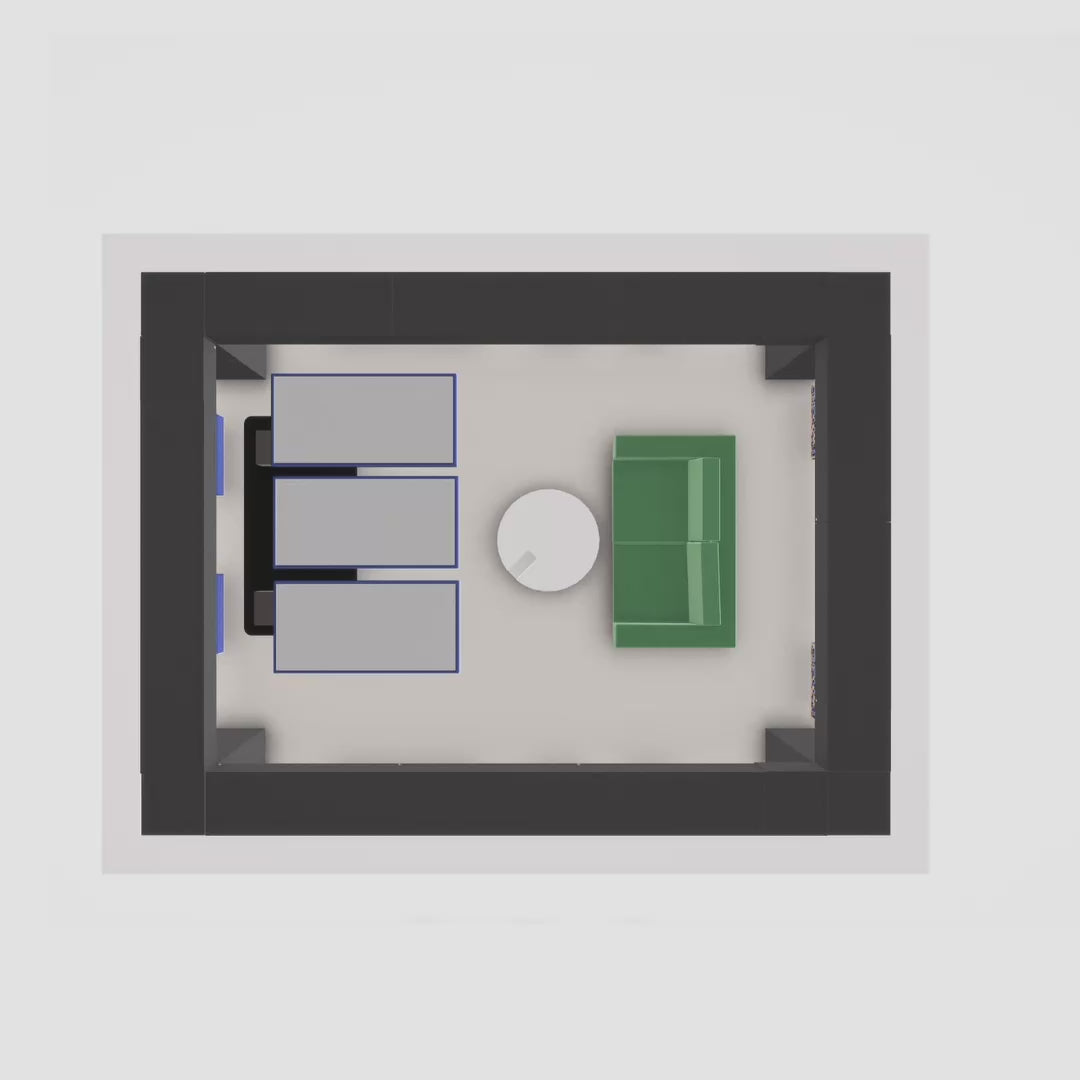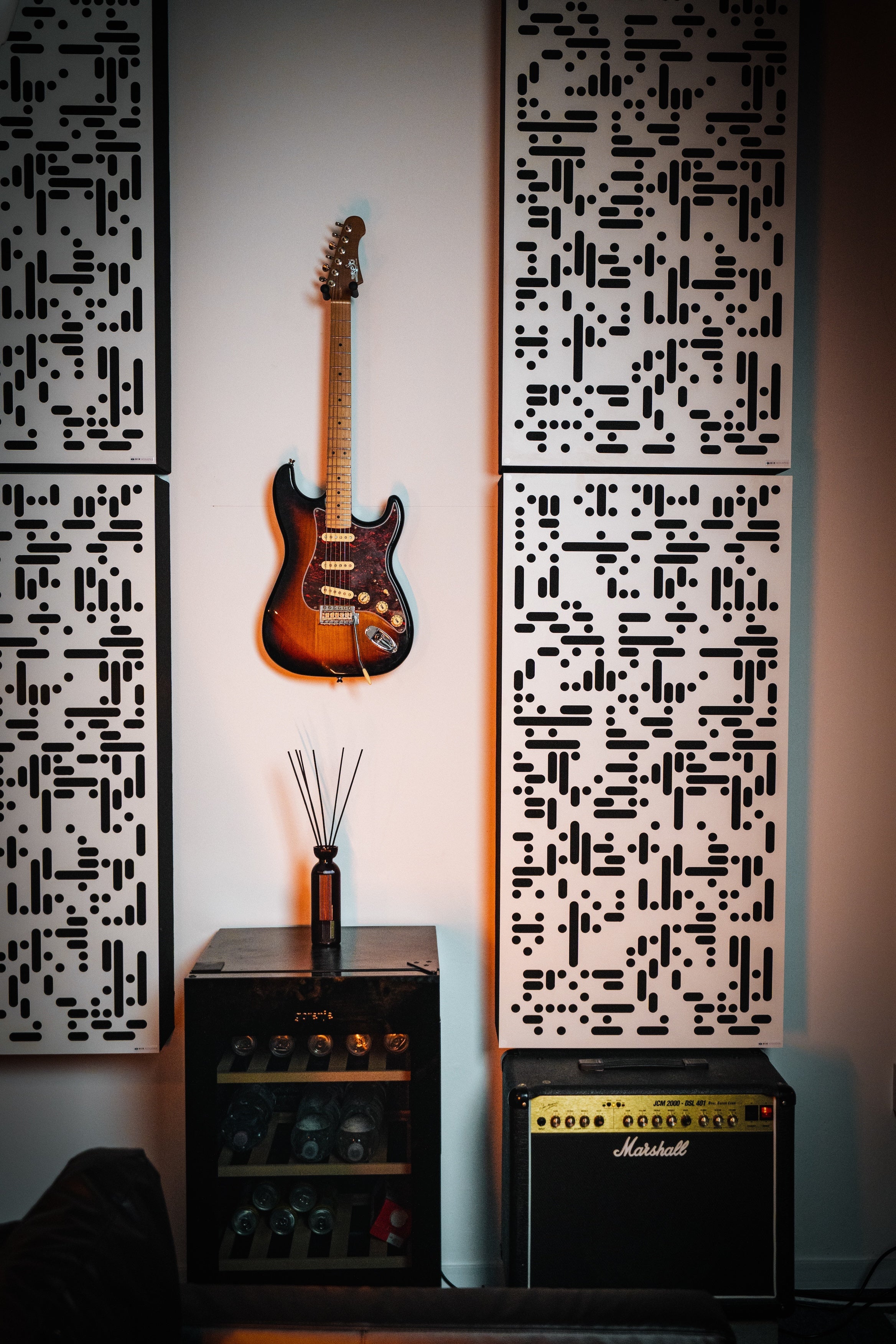
Your room, your way
Our 3D Visualizer allows you to build your room from scratch or choose from pre-designed templates to start customizing immediately. This tool supports realistic modeling of your space, helping you make informed decisions about placement, room treatment options, and color schemes.
Using the GIK Acoustics Visualizer
This tool works for rooms of any size, even small rooms or large rooms with high ceilings.
Choose a room plan
Start from an existing template or create your own custom room design. If you draw a room from scratch, it’s usually best to do just draw a box, then type in the exact desired dimensions for the walls.
Place Products + Experiment
Add acoustic panels, bass traps, and diffusers directly into your drawing. Adjust placements to see how different configurations will look, and how they will impact sound.
Share Your Design with a GIK Designer
Submit your plan through our Advice Form, and our experts will provide recommendations to fine-tune your treatment strategy for optimal results.

Why Room Acoustics Matter
Poor room acoustics can distort sound waves, resulting in harsh environments unpleasant to spend time in, much less try to listen or produce quality audio. The acoustic properties of the room create unwanted resonances, introduce reverb and flutter echoes that degrade room sound quality, and other problems. Proper acoustic treatment absorbs, diffuses, and balances frequencies to ensure a more natural and controlled listening environment.
With our 3D Visualizer, you can visualize the acoustic solutions and strategically place acoustic panels, bass traps, and diffusers in your space, to see what improving sound absorption, diffusion, and frequency response in your room’s size & shape will look like.
Designing Your Space: Key Considerations
If you’re lucky enough to be building a new DIY room from scratch, then designing it with the 3D Visualizer allows you to consider fundamental room design principles that impact room acoustics and sound quality.
Room Shape & Dimensions
Avoid having two dimensions that are identical or evenmultiples of each other, as this can cause standing waves and uneven bass response to line up at the same or similar frequencies. For a deeper dive into this, you can consider room ratios. Aim for room proportions within the “Bolt Area”—a set of ideal room ratios that minimize acoustic distortions.
Listening Position
The ideal listening position is typically about 3/8 of the room length from the front wall, but it’s always best to experiment. Typically if you are listening at the ½ point of the room’s length you will be in a bass null, so it’s best to be a bit forward or backward of that.
Door & Window Placement
Keep doors and windows at least 18 inches away from corners to ensure there’s space for bass traps, which are essential for low-frequency control.
Speaker Placement
Experimentation is always best, but in general we want speakers to be in an equilateral triangle with the listener’s head, and either as close to the front wall as possible, or at least 3-4’ away to minimize SBIR issues.
Early Reflections
Make sure that the early reflection zones on the side walls and ceiling between the loudspeakers and the listeners will have plenty of room for treatments, to keep the balance between direct sound and reflections optimized and achieve good room acoustics.
Room Comfort & Usability
While it's important to have the audio-relevant details of the room set up correctly, we also want to make sure the resulting space is functional and a comfortable space to spend time. The 3D Visualizer allows you to work out these details in advance.
FAQs
What are the benefits of using the 3D Visualizer?
The 3D Visualizer removes the guesswork from acoustic treatment planning. You can see how treatments look in your space, experiment with placement, and fine-tune configurations before purchasing. It’s not necessary! We can still help you even if you don’t use this tool, but for those who enjoy visualizing and experimenting with layout this 3D Visualizer is invaluable.
What should I prioritize when treating my room?
Our Design Team will walk you through the various options, but all rooms benefit from bass traps in corners to control low frequencies. If it’s a listening or recording room, add broadband absorption panels at reflection points for clarity. If you’ll be installing more than a few panels then sometimes it’s worth considering diffusers to maintain a natural sense of space. For good room acoustics design, it’s often best to begin with these on the rear wall, so the speakers fire directly into them.
Can I use the 3D Visualizer for any room size?
Yes! Whether you have a small home studio or a large auditorium, the tool adapts to your needs, allowing for a custom setup tailored to your room dimensions and layout.
How do I submit my 3D design for expert review?
Once you’ve created your layout, you can export your design and submit it through the GIK Acoustics Advice Form. Our acoustic experts will analyze your room and recommend optimal sound-absorbing and diffusion solutions.
What if I’m building a room from scratch?
If you’re designing a new space, consider:
- Keeping room dimensions not closely related to each other to reduce resonances.
- Placing doors and windows strategically to leave space for acoustic treatment in the most critical spots.
- Make sure the layout will result a room that you enjoy spending time in.
- Be clear about whatever soundproofing strategies you will want to deploy to keep sound from leaking in or out of the room. These strategies will require additional space in the room to implement properly, so plan for that.
